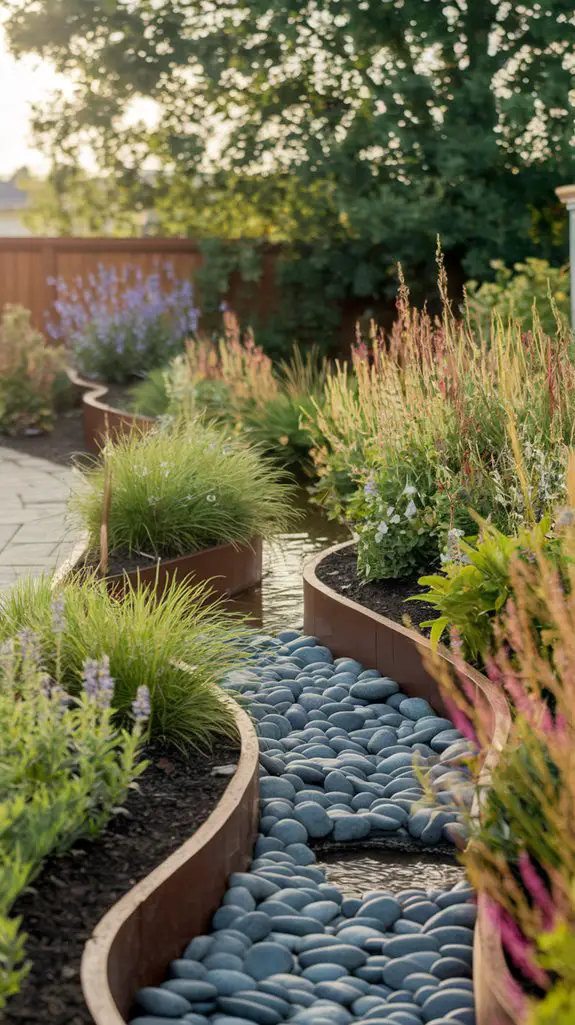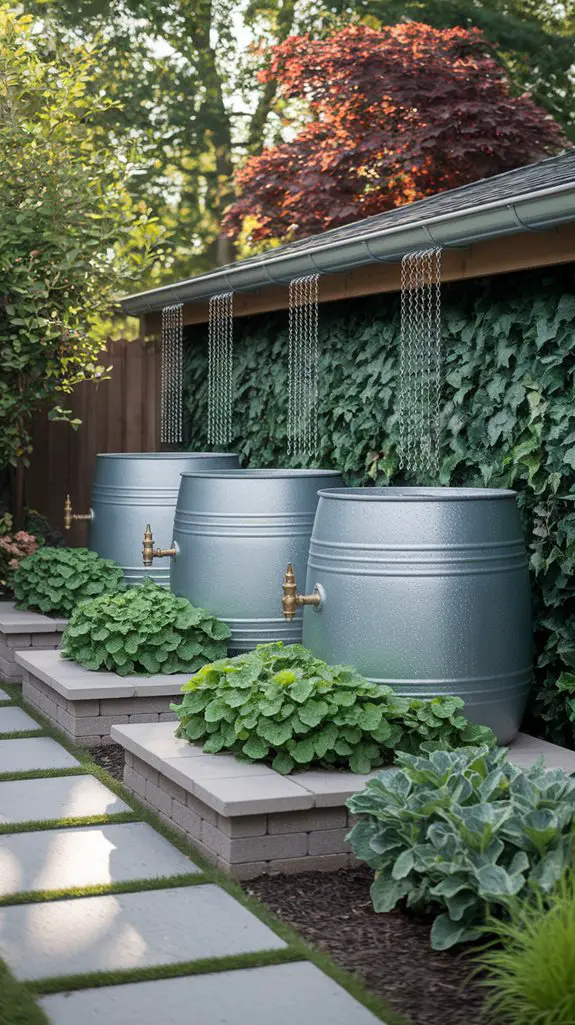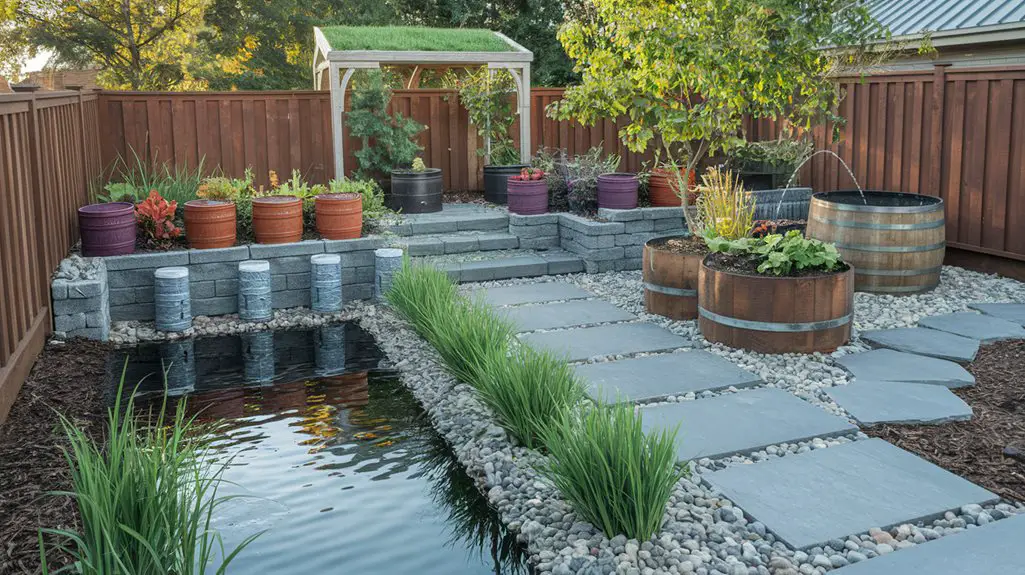With water resources becoming increasingly precious, your backyard rainwater harvesting system might be performing below its full potential. You’ve likely installed a basic rain barrel, but most homeowners capture less than 5% of available roof runoff. Simple modifications can boost collection efficiency by 200-300% while enhancing water quality and reducing utility bills. The following ten strategies will transform your modest setup into a sophisticated water management system that delivers impressive results throughout the year.
Install Multiple Rain Barrels for Increased Capacity
A single rain barrel typically provides only 50-60 gallons of storage, insufficient for extended dry periods.
You’ll need approximately 0.62 gallons per square foot of garden space per week, meaning a 200 sq. ft. garden requires 124 gallons weekly.
Connect multiple barrels using overflow hoses and manifold systems to expand capacity exponentially.
Position barrels at different downspouts to capture runoff from your entire roof surface.
For peak efficiency, install elevated platforms (6-12 inches) to increase water pressure and enable gravity-fed irrigation.
Select uniform barrel types for easier connection and maintenance.
Consider a 3-4 barrel system providing 150-240 gallons of storage—enough to sustain a medium garden through 10-14 days without rainfall while reducing municipal water usage by up to 40% during growing season. Additionally, implementing innovative rainwater systems can further enhance the efficiency and effectiveness of your harvesting setup.
Build a DIY Rain Garden to Capture Overflow

When rain barrels reach capacity during heavy downpours, excess water can become a valuable resource rather than runoff waste. Direct barrel overflow toward a strategically placed rain garden—a depression filled with deep-rooted native plants that absorb 30% more water than conventional lawns.
Choose a location at least 10 feet from your foundation where soil drains well. Dig a basin 4-8 inches deep with gently sloping sides (4:1 ratio) and line the perimeter with stones to prevent erosion. Add a mix of 60% sand, 30% topsoil, and 10% compost to enhance filtration.
Select plants that tolerate both wet and dry conditions, such as switchgrass, black-eyed Susans, or cardinal flowers. This system can process approximately 0.6 gallons per square foot, reducing stormwater runoff while creating habitat for pollinators. Additionally, incorporating native plants promotes biodiversity and supports local ecosystems.
Upgrade Your Gutter System for Maximum Collection

While standard gutter systems capture only 70-80% of roof runoff, strategic upgrades can boost collection efficiency to over 95% with minimal investment.
Start by installing gutter guards to prevent debris blockage and reduce maintenance. These mesh screens cost $1-7 per linear foot but eliminate clogs that divert precious rainwater.
Next, resize downspouts from standard 2×3-inch to 3×4-inch dimensions, increasing flow capacity by 43%. Position additional downspouts at every 20 feet of gutter length rather than the typical 40 feet.
For ideal direction, install adjustable diverters ($15-25 per unit) that automatically route water between storage systems and overflow areas.
Finally, add first-flush diverters to separate the initial runoff containing roof contaminants, ensuring cleaner water enters your storage system. Effective rainwater harvesting systems can significantly enhance the sustainability of your outdoor water features.
Add First-Flush Diverters for Cleaner Water
First-flush diverters greatly improve your harvested rainwater quality by diverting the initial runoff that contains up to 85% of roof contaminants. These simple devices redirect the first 0.5-1 gallon of water per 100 square feet of roof area away from your storage tanks.
Install diverters at each downspout connection to your collection system. Opt for self-draining models with a 4-6 hour reset time to guarantee they’re ready for consecutive rainfall events.
For peak performance, include a debris screen before the diverter and a cleanable chamber for sediment removal.
You’ll need approximately 10 gallons of diversion capacity for every 1,000 square feet of roof area. This investment typically costs $25-75 per downspout but delivers significant returns through cleaner water, reduced tank maintenance, and extended filter life.
Incorporate Permeable Surfaces Throughout Your Yard
Beyond rainwater collection systems, permeable surfaces play an essential role in your overall water management strategy by allowing rainwater to infiltrate the ground rather than becoming runoff.
Replace concrete walkways with permeable pavers that allow 3-5 gallons of water per square foot to seep through. Install gravel driveways which can absorb up to 30% more water than asphalt.
Consider rain gardens in low areas, which can process 30% more runoff than conventional lawns while filtering pollutants. Rain gardens are particularly effective in capturing and utilizing rainfall.
Studies show properties with 30%+ permeable surfaces reduce stormwater runoff by 65%. You’ll also decrease erosion and replenish groundwater supplies.
For best results, combine multiple permeable elements—each square foot can divert approximately 600 gallons of water annually from storm drains while maintaining natural hydrological cycles.
Set Up Gravity-Fed Irrigation Systems for Efficient Use
Once you’ve collected rainwater, gravity-fed irrigation systems provide the most energy-efficient distribution method, operating without electricity while delivering 1.5-2 gallons per minute to your plants.
To create an effective gravity-fed system:
- Position your collection barrel at least 2 feet higher than your garden bed to guarantee adequate pressure (approximately 0.433 psi per foot of elevation).
- Use 1/2-inch polyethylene tubing as your mainline with 1/4-inch soaker lines for distribution to reduce clogging by 75%.
- Install a 100-micron filter between the barrel and irrigation lines to prevent sediment buildup.
- Add a pressure reducer if your elevation differential exceeds 10 feet to prevent damage to drip emitters.
This configuration maximizes water efficiency by delivering moisture directly to root zones, reducing evaporation by up to 60% compared to overhead watering methods. Implementing a rainwater filtration system can further enhance the quality of the water delivered to your plants.
Create Swales and Berms to Direct Water Flow
Swales and berms represent complementary earthworks that strategically manage rainwater flow across your property, increasing groundwater recharge by 30-40% compared to traditional landscaping.
Excavate shallow, gently sloping channels (swales) on contour lines, with excavated soil forming raised berms on the downhill side.
For ideal results, design swales at 2% grade with a minimum 1:3 width-to-depth ratio. Position them perpendicular to water flow, spacing multiple swales at intervals of 3-5 times their width.
Plant deep-rooted native vegetation on berms to stabilize soil and enhance infiltration.
In urban settings, even miniature 6-12 inch deep swales can redirect 85% of runoff from impermeable surfaces.
You’ll reduce erosion, prevent flooding, and create naturally irrigated planting zones without mechanical intervention—all while replenishing local aquifers. Additionally, implementing these systems can significantly improve rainwater management strategies in your overall backyard design.
Install Underground Cisterns for Large-Scale Storage
Underground cisterns provide substantial rainwater storage capacity, ranging from 1,500 to 10,000+ gallons, while preserving valuable yard space and protecting water quality through temperature regulation.
When planning your underground system, you’ll need to evaluate several critical factors for maximum performance:
- Install a first-flush diverter to prevent sediment and contaminants from entering your storage system.
- Incorporate a properly sized submersible pump (1/2 to 1 HP) for efficient water distribution.
- Include an overflow pipe sized at least 2″ diameter larger than your intake pipe.
- Position the tank at least 10 feet from building foundations to prevent structural issues.
Professional installation costs between $2-$5 per gallon of capacity, but you’ll recoup this investment through reduced water bills and increased property resilience during drought conditions. Additionally, rainwater harvesting systems can significantly reduce your reliance on municipal water sources, further enhancing your sustainability efforts.
Implement Roof Washers and Filters for Better Water Quality
While rainwater naturally falls clean from the sky, it collects various contaminants as it travels across your roof surface, including dust, pollen, bird droppings, and decomposing organic matter.
To maintain water quality, install a first-flush diverter that discards the initial 0.5-1 gallon of runoff per 100 square feet of roof area.
Add a 30-micron sediment filter after your diverter to remove particulates, followed by a 5-micron activated carbon filter for chemical contaminants. Additionally, consider using rainwater collection barrels to efficiently store the filtered water for later use.
For potable applications, incorporate UV filtration that delivers a minimum 40 mJ/cm² dose to neutralize 99.99% of microorganisms.
Check and clean filters monthly during heavy rain seasons. Replace sediment filters quarterly and carbon filters semi-annually to maintain peak filtration efficiency and prevent system clogging.
Connect Harvesting Systems to Indoor Non-Potable Uses
Once your filtration system is properly established, extending rainwater usage beyond the garden into your home maximizes harvesting efficiency and utility savings. Connecting your harvesting system for indoor non-potable applications can reduce municipal water consumption by 30-50% in average households.
Consider these practical connection points:
- Toilet flushing – Each flush uses 1.6-7 gallons, making it an ideal candidate with potential savings of 24-40 gallons per person daily.
- Laundry systems – Connect directly to washing machines, which consume 15-30 gallons per load.
- Utility sinks – Perfect for cleaning tasks where potable water isn’t necessary.
- HVAC systems – Cooling towers and evaporative coolers benefit from rainwater’s low mineral content.
Additionally, integrating rainwater systems into your home’s design promotes a more sustainable lifestyle.
Install a dedicated plumbing system with color-coded pipes and backflow preventers to comply with local building codes and prevent cross-contamination.
Conclusion
By implementing these ten rainwater harvesting techniques, you’ll considerably increase collection efficiency by up to 60%. Your system will operate with clockwork precision, reducing municipal water consumption while creating a self-sustaining garden ecosystem. Don’t wait for the tempests of tomorrow—act today to optimize your household’s water resilience. With strategic placement and proper maintenance, your harvesting network will serve as both environmental steward and practical resource for years to come.




